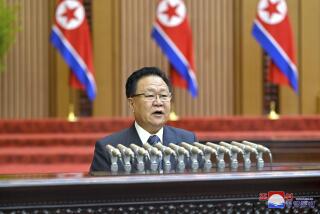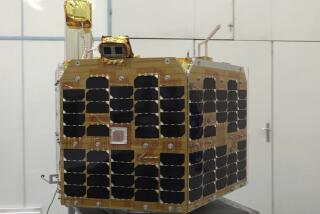North Korea plans long-range rocket launch
BEIJING -- North Korea announced Saturday that it will send a long-range rocket into space this month, trying to make up for a public-relations disaster in April when a much-hyped launch failed.
In the announcement attributed to a spokesman for the Korean Committee for Space Technology, North Korea said the rocket would carry a “polar-orbiting Earth observation satellite” for “peaceful scientific and technological” purposes.
Nonetheless, the launch is seen as a defiant move for an impoverished country that is already subject to a U.S. ban from developing nuclear and missile technology.
PHOTOS: North Korea’s April launch preparations
The timing -- between Dec. 10 and 22, according to the announcement -- coincides with several sensitive dates on the Korean calendar.
On Dec. 19 there is a closely contested presidential election in archrival South Korea that could be swayed by the rocket launch. Perhaps more important on the North Korean calendar, Dec. 17 marks the one-year anniversary of the death of longtime leader Kim Jong Il, who is believed to have ordered the launch.
A successful launch is also seen as key to establishing the legitimacy of successor Kim Jong Un, the late dictator’s son who is still in his 20s.
North Korea had been in the midst of a propaganda campaign, claiming that it would become a “strong and prosperous nation” by 2012, which happens to be the centennial of the birth of Kim Il Sung, the dynasty’s founder.
PHOTOS: Rare glimpse of North Korea
“It seems like they are trying to keep up with their declaration that the year 2012 will be the first year of ‘strong and prosperous nation,’” said Koh Yoo-hwan, North Korean studies professor at South Korea’s Dongguk University. “Because that had failed, they will try and finish the project within this year.”
The earlier launch was an embarrassment for the regime, which had invited foreign television crews into North Korea to publicize the feat. But the rocket flew for less than two minutes before splashing into the Yellow Sea, close enough to South Korea that its intelligence services were able to recover pieces to analyze.
“The purpose of a rocket launch is for domestic politics,” said another South Korean specialist, Baek Seung-joo at Korea Institute for Defense Analyses. “This is their chance to recover from embarrassment in April, and also to strengthen the Kim Jong Un-centered leadership.”
In the announcement, North Korea said the satellite, known as Kwangmyongsong-3, meaning “bright star,” had been “manufactured by its own efforts and with its own technology, true to the behests of leader Kim Jong Il.”
“Scientists and technicians of the DPRK [North Korea] analyzed the mistakes that were made during the previous April launch and deepened the work of improving the reliability and precision of the satellite and carrier rocket, thereby rounding off the preparations to launch,” the statement read.
The April launch was the third attempt for North Korea, the last two having taken place in 1998 and 2009. This launch, like the attempt in April, is to take place from the Sohae military installation on the country’s west coast near the border with China, and is probably headed south toward the Philippines. The 1998 and 2009 launches, directed to the east, caused great consternation in Japan.
Technologically, launching an intercontinental ballistic missile or satellite is essentially the same, with the main difference being what the rocket is carrying. The fact that North Korea is simultaneously developing nuclear weapons has raised fears that eventually the United States could be within its range.
South Korea’s first rocket from its own territory, Naro-1, was scheduled to launch Thursday, but was delayed until next year because of technical problems.
In a statement, the South Korean foreign ministry said Thursday that the North’s planned launch is “a grave provocation and a head-on challenge to the international community.”
The North Korean statement was not a surprise because satellite intelligence released in recent days showed a movement of trucks around the launch site, according to 38 North, a think tank affiliated with Johns Hopkins University.
“If Pyongyang follows past practice in preparing for a launch, it could be ready to fire a rocket as early as the end of the first week in December,” 38 North said in the report released Wednesday.
Demick reported from Beijing and Choi from Seoul.
More to Read
Sign up for Essential California
The most important California stories and recommendations in your inbox every morning.
You may occasionally receive promotional content from the Los Angeles Times.










